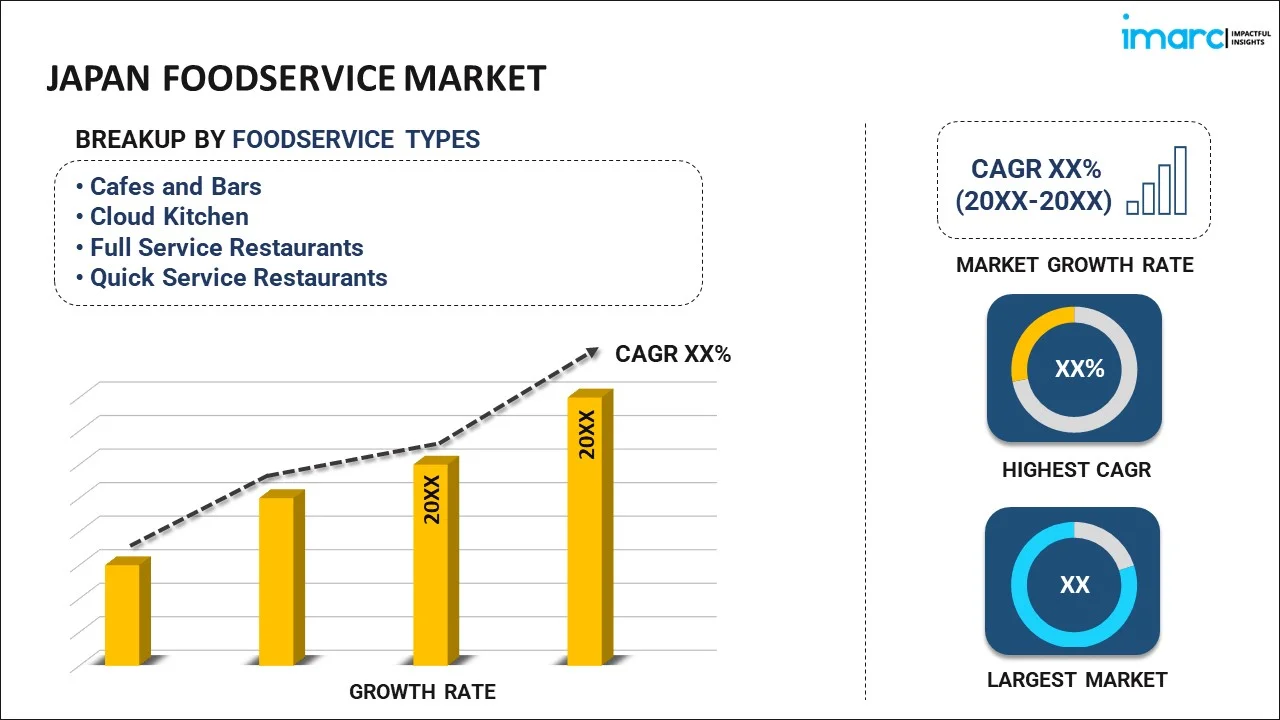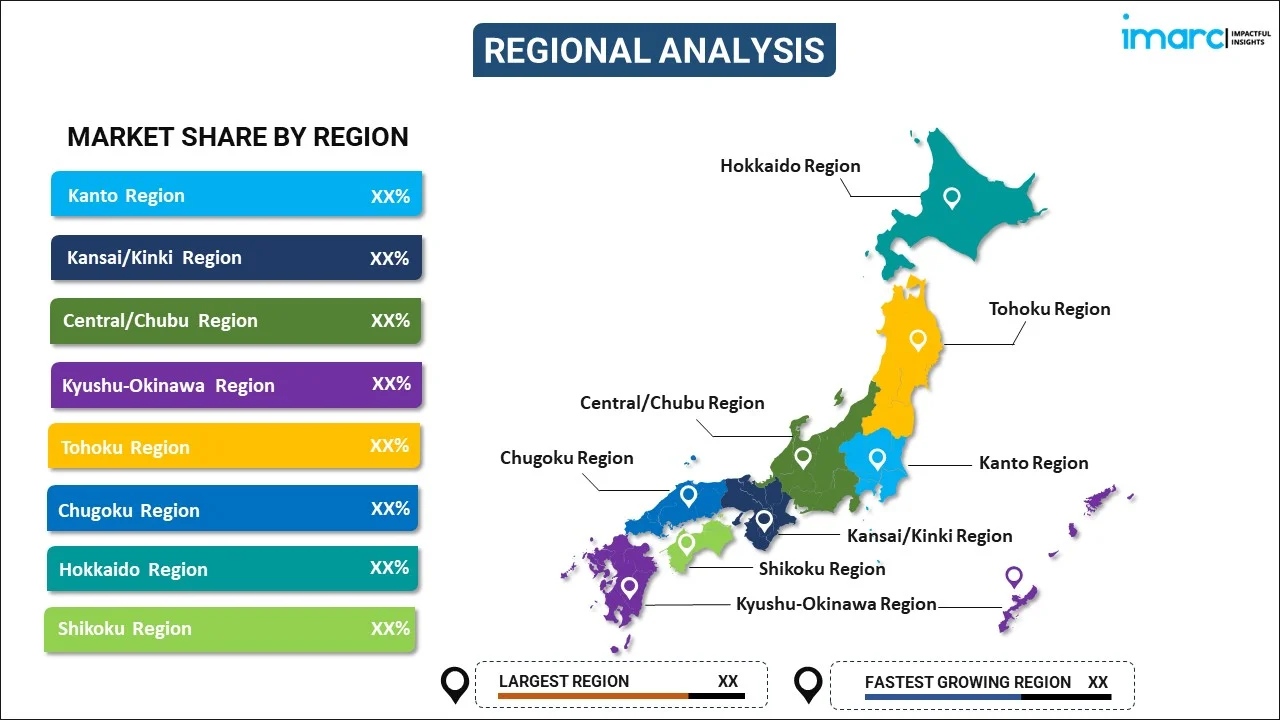
Japan Foodservice Market Report by Foodservice Type (Cafes and Bars, Cloud Kitchen, Full Service Restaurants, Quick Service Restaurants), Outlet (Chained Outlets, Independent Outlets), Location (Leisure, Lodging, Retail, Standalone, Travel), and Region 2025-2033
Market Overview:
Japan foodservice market size reached USD 256.5 Billion in 2024. Looking forward, IMARC Group expects the market to reach USD 752.4 Billion by 2033, exhibiting a growth rate (CAGR) of 12.7% during 2025-2033. The ever-evolving preferences and lifestyles of consumers, coupled with a rise in demand for food delivery services, quick-service restaurants, and ready-to-eat meals is driving the market growth.
|
Report Attribute
|
Key Statistics
|
|---|---|
|
Base Year
|
2024
|
|
Forecast Years
|
2025-2033
|
|
Historical Years
|
2019-2024
|
|
Market Size in 2024
|
USD 256.5 Billion |
|
Market Forecast in 2033
|
USD 752.4 Billion |
| Market Growth Rate 2025-2033 | 12.7% |
Foodservice refers to the industry and practice of preparing, serving, and delivering food and beverages to customers in various settings, such as restaurants, cafeterias, catering events, and more. It encompasses a wide range of establishments and businesses that provide food-related services. In the foodservice industry, food is typically prepared by professional chefs or cooks, and it can range from fast food to fine dining. Foodservice operations can be found in diverse settings, including hotels, schools, hospitals, airports, and sports venues. The industry also includes food delivery services and food trucks, which have gained popularity in recent years. Foodservice establishments must adhere to strict hygiene and safety standards to assure the quality and safety of the food they serve. Additionally, they often focus on customer satisfaction, menu development, and pricing strategies to remain competitive in the market.
Japan Foodservice Market Trends:
One of the primary catalysts propelling the foodservice market growth is the shifting preferences and lifestyles of consumers in Japan. The fast-paced nature of modern life and the increasing prevalence of dual-income households have generated a remarkable upswing in the desire for convenient, ready-to-eat meals. Furthermore, in response to consumers' quest for diverse and effortless dining experiences, the foodservice industry has embraced an extensive range of culinary offerings, quick-service alternatives, and delivery solutions. Additionally, the emergence of millennial and Gen Z populations has wielded a profound influence on the foodservice sector. These younger demographics prioritize experiences and exhibit a willingness to explore inventive and distinct culinary choices. Apart from this, the industry has witnessed a surge in the appeal of themed eateries, fusion cuisine, and immersive dining concepts. Furthermore, the escalating popularity of health-conscious menu items, plant-based substitutes, and transparent sourcing practices, aligning with the growing awareness of environmental and health-related concerns is expected to drive the foodservice market in Japan during the forecast period.
Japan Foodservice Market Segmentation:
IMARC Group provides an analysis of the key trends in each segment of the market, along with forecasts at the country level for 2025-2033. Our report has categorized the market based on foodservice type, outlet, and location.
Foodservice Type Insights:

- Cafes and Bars
- Cuisine Type
- Bars and Pubs
- Cafes
- Juice/Smoothie/Desserts Bars
- Specialist Coffee and Tea Shops
- Cuisine Type
- Cloud Kitchen
- Full Service Restaurants
- Cuisine Type
- Asian
- European
- Latin American
- Middle Eastern
- North American
- Others
- Cuisine Type
- Quick Service Restaurants
- Cuisine Type
- Bakeries
- Burger
- Ice Cream
- Meat-based Cuisines
- Pizza
- Others
- Cuisine Type
The report has provided a detailed breakup and analysis of the market based on the foodservice type. This includes cafes and bars [cuisine type (bars and pubs, cafes, juice/smoothie/desserts bars, and specialist coffee and tea shops)], cloud kitchen, full service restaurants [cuisine type (asian, european, latin american, middle eastern, north american, and others)], and quick service restaurants [cuisine type (bakeries, burger, ice cream, meat-based cuisines, pizza, and others)].
Outlet Insights:
- Chained Outlets
- Independent Outlets
A detailed breakup and analysis of the market based on the outlet have also been provided in the report. This includes chained outlets and independent outlets.
Location Insights:
- Leisure
- Lodging
- Retail
- Standalone
- Travel
The report has provided a detailed breakup and analysis of the market based on the location. This includes leisure, lodging, retail, standalone, and travel.
Regional Insights:

- Kanto Region
- Kansai/Kinki Region
- Central/ Chubu Region
- Kyushu-Okinawa Region
- Tohoku Region
- Chugoku Region
- Hokkaido Region
- Shikoku Region
The report has also provided a comprehensive analysis of all the major regional markets, which include Kanto Region, Kansai/Kinki Region, Central/ Chubu Region, Kyushu-Okinawa Region, Tohoku Region, Chugoku Region, Hokkaido Region, and Shikoku Region.
Competitive Landscape:
The market research report has also provided a comprehensive analysis of the competitive landscape. Competitive analysis such as market structure, key player positioning, top winning strategies, competitive dashboard, and company evaluation quadrant has been covered in the report. Also, detailed profiles of all major companies have been provided.
Japan Foodservice Market Report Coverage:
| Report Features | Details |
|---|---|
| Base Year of the Analysis | 2024 |
| Historical Period | 2019-2024 |
| Forecast Period | 2025-2033 |
| Units | Billion USD |
| Scope of the Report | Exploration of Historical and Forecast Trends, Industry Catalysts and Challenges, Segment-Wise Historical and Predictive Market Assessment:
|
| Foodservice Types Covered |
|
| Outlets Covered | Chained Outlets, Independent Outlets |
| Locations Covered | Leisure, Lodging, Retail, Standalone, Travel |
| Regions Covered | Kanto Region, Kansai/Kinki Region, Central/ Chubu Region, Kyushu-Okinawa Region, Tohoku Region, Chugoku Region, Hokkaido Region, Shikoku Region |
| Customization Scope | 10% Free Customization |
| Post-Sale Analyst Support | 10-12 Weeks |
| Delivery Format | PDF and Excel through Email (We can also provide the editable version of the report in PPT/Word format on special request) |
Key Questions Answered in This Report:
- How has the Japan foodservice market performed so far and how will it perform in the coming years?
- What has been the impact of COVID-19 on the Japan foodservice market?
- What is the breakup of the Japan foodservice market on the basis of foodservice type?
- What is the breakup of the Japan foodservice market on the basis of outlet?
- What is the breakup of the Japan foodservice market on the basis of location?
- What are the various stages in the value chain of the Japan foodservice market?
- What are the key driving factors and challenges in the Japan foodservice?
- What is the structure of the Japan foodservice market and who are the key players?
- What is the degree of competition in the Japan foodservice market?
Key Benefits for Stakeholders:
- IMARC’s industry report offers a comprehensive quantitative analysis of various market segments, historical and current market trends, market forecasts, and dynamics of the Japan foodservice market from 2019-2033.
- The research report provides the latest information on the market drivers, challenges, and opportunities in the Japan foodservice market.
- Porter's five forces analysis assist stakeholders in assessing the impact of new entrants, competitive rivalry, supplier power, buyer power, and the threat of substitution. It helps stakeholders to analyze the level of competition within the Japan foodservice industry and its attractiveness.
- Competitive landscape allows stakeholders to understand their competitive environment and provides an insight into the current positions of key players in the market.
Need more help?
- Speak to our experienced analysts for insights on the current market scenarios.
- Include additional segments and countries to customize the report as per your requirement.
- Gain an unparalleled competitive advantage in your domain by understanding how to utilize the report and positively impacting your operations and revenue.
- For further assistance, please connect with our analysts.
 Inquire Before Buying
Inquire Before Buying
 Speak to an Analyst
Speak to an Analyst
 Request Brochure
Request Brochure
 Request Customization
Request Customization




.webp)




.webp)












